Global equity markets stumbled in August (MSCI World -2.3% MoM) but remained solidly in positive territory YTD (MSCI World +16.6% YTD). Despite the bulk of the year’s equity market returns coming from US-domiciled, mega-cap tech and chip companies, this area of the market held up relatively well (S&P 500 -1.6% MoM, NYSE Fang Index -2.5% MoM). The S&P 500’s 2Q23 corporate results season wrapped up with earnings marginally down (-2.6% YoY) but c. 6% ahead of consensus analyst expectations.
A key headwind for risk assets in August was rising yields, with the US 10-year bond yield reaching its highest level since 2007 by mid-month (4.35%) before retreating slightly to 4.1% into month-end. The yield-sensitive sectors were unsurprisingly the worst-performing cohort in August, with the real estate, consumer staples and utility sectors of the S&P 500 Index down 3.0%, 3.6% and 6.2% MoM, respectively. Energy shares (+1.8% MoM) were the best-performing sector for a second consecutive month, as Brent crude oil (+1.5% MoM) clawed its way back into positive territory for the year (+1.1% YTD).
European stocks struggled in August (-5.3% MoM in US dollar terms), particularly the luxury goods companies, which are heavily geared towards Chinese consumers, with Chinese economic activity continuing to disappoint in August. The latest data showed that Chinese economic activity is still struggling to recover meaningfully post-COVID-19, with disappointing retail sales, prices slipping into deflation and falling real estate activity.
Emerging market (EM) stocks (MSCI EM -6.1% MoM) fared even worse than those in developed markets (DMs), with Chinese companies the biggest drag (particularly those listed offshore, with the indices of Chinese companies in Hong Kong and the US falling by 8.7% and 10.3% MoM, respectively, in US dollar terms). Weak Chinese economic activity also weighed on commodity prices (Bloomberg Industrial Metals Index -5.1% MoM).
The higher global yields were catalysed by stronger than anticipated US economic activity and consistent rhetoric from US Federal Reserve (Fed) members (via the release of the latest Fed minutes and then through the speakers at the global central bankers’ conference in Jackson Hole) that there is still room for more rate hikes with upside risks to inflation. Higher rates dragged the US dollar with them, leaving the greenback stronger against all major currencies (except the Turkish lira, which was up 1% MoM but is still down 30% YTD).




